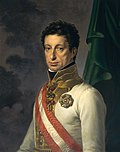| Picture | Name | Took office | Left office | Relationship to monarch | Appointed by |
|---|
 | Engelbert II of Nassau
(1451–1504) | 1501 | 1504 | / |  
Maximilian I, Holy Roman Emperor for Philip the Handsome |
 | William de Croÿ
(1458–1521) | 1504 | 1507 | / |   Maximilian I for Charles of Ghent Maximilian I for Charles of Ghent |
 | Margaret of Austria
(1480–1530) | 1507 | 1 December 1530
(death) | Aunt of Charles |
| Charles became Duke of Burgundy in 1506 (emancipated in 1515), King of Spain and the Two Sicilies in 1516, Archduke of Austria and Holy Roman Emperor as Charles V in 1519 at the death of Maximilian. |
 | Mary of Austria
(1505–1558) | January 1531 | October 1555 | Sister | 
Charles V, Holy Roman Emperor |
 | Emmanuel Philibert of Savoy
(1528–1580) | 1555 | 1559 | Cousin of Philip |  
Charles V for his son Philip. |
| In 1556, Philip V, Duke of Burgundy, became king of Spain as Philip II, thereby bringing the Habsburg Netherlands under Spanish control. |
 | Margaret of Parma
(1522–1586) | 1559 | 1567 | Half-sister | 
Philip II of Spain |
 | Fernando Álvarez de Toledo, 3rd Duke of Alba
(1507–1582) | 1567 | 1573 | / |
 | Luis de Requesens y Zúñiga
(1528–1576) | 1573 | 5 March 1576
(death) | / |
 | John of Austria
(1547–1578) | 1576 | 1 October 1578
(death) | Half-brother |
 | Alexander Farnese, Duke of Parma
(1545–1592) | 1578 | 3 December 1592
(death) | Half-nephew |
 | Peter Ernst I von Mansfeld-Vorderort
(1517–1604) | 1592 | 1594 | / |
 | Ernest of Austria
(1553–1595) | 1594 | 20 February 1595
(death) | Nephew |
 | Pedro Henriquez de Acevedo, Count of Fuentes
(1525–1610) | 1595 | 1596 | / |
 | Albert of Austria
(1559–1621) | 1596 | 1598 | Nephew |
| In 1598, Philip II of Spain ceded the Netherlands to his daughter Isabella Clara Eugenia and nephew Albert, who married the next year. They reigned together until his death, when the Netherlands passed to their nephew, Philip IV of Spain, in whose name Isabella Clara Eugenia governed the countries until her death. |
 | Isabella Clara Eugenia of Austria
(1566–1633) | 1621 | 1 December 1633
(death) | Aunt | 
Philip IV of Spain |
 | Ferdinand of Austria
(1609/1610–1641) | 1633 | 9 November 1641
(death) | Brother |
 | Francisco de Melo
(1597–1651) | 1641 | 1644 | / |
 | Manuel de Moura
(1590–1651) | 1644 | 1647 | / |
 | Leopold William of Austria
(1614–1662) | 1647 | 1656 | Cousin |
 | John of Austria the Younger
(1629–1679) | 1656 | 1659 | Son |
 | Luis de Benavides Carrillo
(1608–1668) | 1659 | 1664 | / |
 | Francisco de Moura
(1610–1675) | 1664 | 1668 | / |
 Charles II of Spain |
 | Íñigo Melchor de Velasco
(1608–1668) | 1668 | 1670 | / |
 | Juan Domingo de Zuñiga y Fonseca
(1640–1716) | 1670 | 1675 | / |
 | Carlos de Aragón de Gurrea
(1634–1692) | 1675 | 1677 | / |
 | Alexander Farnese
(1635–1689) | 1678 | 1682 | Second Cousin |
| Ottone Enrico del Caretto
(1629–1685) | 1682 | 1685 | / |
 | Francisco Antonio de Agurto
(1640–1702) | 1685 | 1692 | / |
 | Maximilian II Emanuel of Bavaria
(1662–1726) | 1692 | 1706 | Nephew-in-law |
| Uncle | 
Philip V of Spain |
 | Isidoro de la Cueva y Benavides (acting)
(1652–1723) | 1701 | 1704 | During the absence of Maximilian of Bavaria |
| Following the War of the Spanish Succession, Holy Roman Emperor Charles VI became ruler of the Austrian Netherlands. |
 | Eugene of Savoy
(1663–1736) | 1716 | 1724 | Third cousin | 
Charles VI, Holy Roman Emperor |
 | Wirich Philipp von Daun
(1669–1741) | February 1725 | October 1725 | / |
 | Maria Elisabeth of Austria
(1680–1741) | 1725 | 26 August 1741
(death) | Sister |
| Aunt | 
Maria Theresa of Austria |
 | Friedrich August von Harrach-Rohrau
(1696–1749) | 1741 | 1744 | / |
 | Maria Anna of Austria
(1718–1744) | 1744 | 16 December 1744
(death) | Sister |
 | Charles Alexander of Lorraine
(1712–1780) | 4 July 1780
(death) | Brother-in-law |
 | Maria Christina of Austria-Lorraine
(1742–1798)
with
Albert Casimir of Saxony
(1738–1822) | 1781 | 1793 | Sister and brother-in-law | 
Joseph II, Holy Roman Emperor |

Leopold II, Holy Roman Emperor |
| Aunt and uncle | 
Francis II, Holy Roman Emperor |
 | Charles of Austria-Lorraine
(1771–1847) | 1793 | 1794 | Brother |

















































